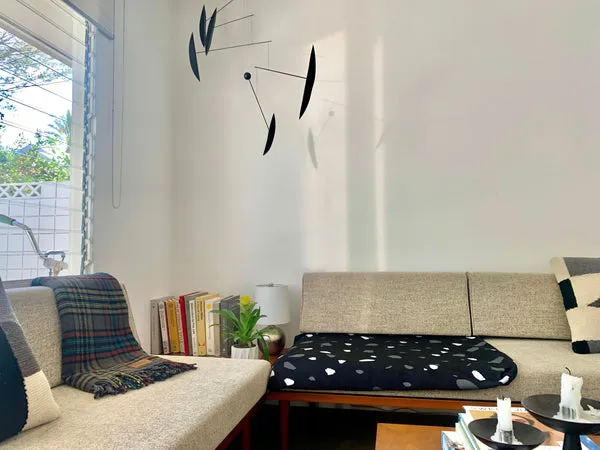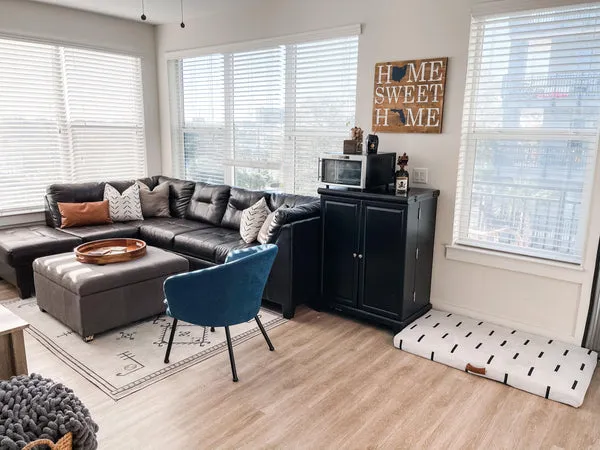For many dog owners, the couch presents a classic dilemma: do you allow your furry friend to claim a spot on the sofa, or do you establish it as an off-limits zone? While some pet parents embrace cuddle time on the furniture, others prefer to keep their sofas pristine and dog-free. If you’re in the latter group, knowing how to train your dog to stay off the couch is a crucial skill. Fortunately, with consistency and the right approach, this can be a relatively straightforward training process, often achievable in just a few days. This guide will walk you through effective methods for teaching your dog proper couch etiquette, ensuring a harmonious living space for everyone. You can learn more about general training principles and how to teach a dog to stay off couch through various resources.
The Block Method: Preventing Access
One of the simplest and most effective strategies, especially for older dogs with established habits, is the block method. This approach physically prevents your dog from accessing the couch. When you are home, you can simply occupy the entire sofa yourself, leaving no room for your pup to jump up. If there’s no available space, they won’t feel the need to try.
For times when you’re not actively on the couch or not home, you can use physical barriers. Baby gates, large decorative objects, or even a stack of pillows can serve as effective deterrents. Many stylish pet gates are available that won’t disrupt your home’s aesthetic. Moving ottomans to block the path to the sofa is another practical option.
 A decorative pet gate blocking access to a comfortable living room couch.
A decorative pet gate blocking access to a comfortable living room couch.
Teaching the ‘Off’ Command for Couch Manners
While blocking access is a great preventative measure, teaching your dog specific commands provides a more comprehensive training solution. The “off” command is fundamental for dogs that tend to jump onto furniture. Start by sitting near your couch and observing your dog. The moment they attempt to hop onto the furniture, or are already on it, approach them with a treat or their favorite toy. Clearly say “off” to indicate your desire for them to get down. Use the treat to lure them off the couch and onto the floor. Consistently repeat this process, rewarding them immediately when they respond correctly to the “off” command.
Some owners also find it useful to teach an “up” command, especially if they occasionally want their dog to join them on the couch. This teaches your dog that going on the furniture requires an invitation. You might use a designated blanket or a removable dog bed cover to create an inviting, protected spot for them. To teach “up,” you might use a leash for gentle guidance. Enthusiastically say “up!” while patting the desired spot. Lure them with a treat or toy. If needed, gently guide them with the leash. Once they’re in place, reward them with praise or a treat. This creates a clear boundary: they only go on the couch when given permission, reinforcing the “off” command for uninvited attempts. For more insights on how to train your dogs to stay off the couch with commands, consistency is key.
 A dog sitting on the floor next to a couch, indicating successful 'off' command training.
A dog sitting on the floor next to a couch, indicating successful 'off' command training. A modern dog bed cover placed on a sofa, allowing the dog to join on invitation.
A modern dog bed cover placed on a sofa, allowing the dog to join on invitation.
The ‘Spot’ or ‘Place’ Method: Offering Alternatives
Another excellent strategy is to provide your dog with an appealing alternative to the couch. Placing a comfortable dog bed in the same room as your sofa can be highly effective. You can then teach your dog the “place” or “bed” command. This command directs them to their designated spot, preventing them from gravitating towards the couch.
When your dog moves towards the couch, calmly say “place” and guide them towards their bed. Use small treats to reward them as they move towards and settle in their bed. For more stubborn dogs, a gentle nudge with a leash can help direct them. As your dog begins to understand and respond to the “place” command, gradually reduce the frequency of treats. The ultimate goal is for them to choose their bed over the sofa naturally. Actively watch your dog when you enter the room and reward them specifically for going to their bed instead of the couch. This positive reinforcement solidifies the idea that the sofa is an off-limits area, while their bed is their personal sanctuary.
 A stylish dog bed positioned near a living room couch as an inviting alternative.
A stylish dog bed positioned near a living room couch as an inviting alternative.
Maintaining Couch Boundaries When You’re Away
Even after your dog has mastered staying off the couch in your presence, they might see your absence as an invitation to break the rules. Many owners discover this through pet cameras, witnessing their dogs happily lounging on the sofa the moment they leave. To prevent this, reinforcing boundaries when you’re not home is crucial.
The easiest solution is to block access to the couch or the room entirely. A baby gate across the doorway leading to the living room can be very effective. Alternatively, crate training your dog can provide a safe and controlled environment while you’re away, preventing destructive behaviors and keeping them off furniture. While crate training requires patience, it offers numerous benefits for both you and your pup. If crating isn’t an option, consider using deterrents like specific scents or textures that dogs dislike, observing their reaction to find an effective solution. Exploring basic dog obedience classes near me can also provide structured guidance for these and other training challenges.
 A dog resting comfortably in its designated bed, practicing the 'place' command.
A dog resting comfortably in its designated bed, practicing the 'place' command.
Conclusion
Successfully training your dog to stay off the couch relies heavily on consistency, patience, and clear communication. Whether you use physical barriers, teach specific commands like “off” and “place,” or offer attractive alternatives, the key is to be unwavering in your expectations. Ensure everyone in your household understands and practices the same training methods to avoid sending mixed signals to your dog. Regular reinforcement will help your dog understand the boundaries, leading to a more disciplined and harmonious home environment. If you’re looking for further support or wish to address other common behavioral issues like how to stop dog barking at nothing, professional guidance through online dog training programs can offer expert insights and tailored strategies.
